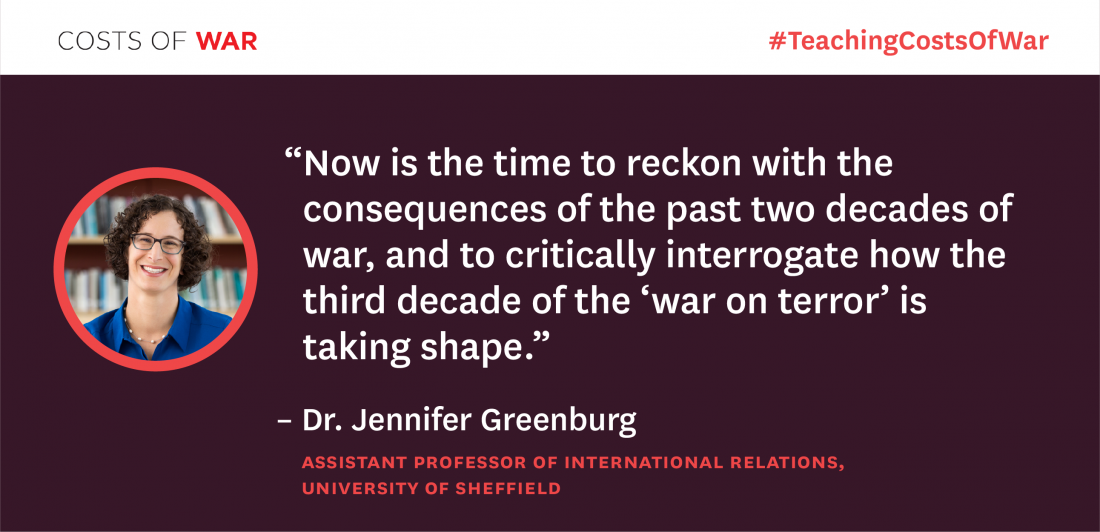Educator Spotlight: Dr. Jennifer Greenburg, Assistant Professor of International Relations
Teaching Costs of War: A Q&A With Dr. Jennifer Greenburg

Your syllabus, ‘Twenty Years of War: The Causes and Costs of the Post-9/11 Wars’ focuses on the temporal range and costs of these wars, from historical beginnings to exploring peaceful alternatives to war for current and future conflicts. As the U.S. has now officially withdrawn troops from Afghanistan, what in your view is the value of teaching about the post-9/11 wars in particular?
It is more important now than ever to teach about the post-9/11 wars. Unfortunately, much of the media and official government discourse of the Afghanistan withdrawal portrays the wars as now over. This is inaccurate. As Costs of War has shown, the wars have morphed in form and expanded in geography to cover 85 countries, or 40 percent of the countries on the surface of Earth. The classroom is a powerful place to examine how the wars also continue through immigration restrictions, terrorism prosecutions, surveillance, and Islamophobia. Now is the time to reckon with the consequences of the past two decades of war, and to critically interrogate how the third decade of the ‘war on terror’ is taking shape, for instance through counterterrorism programs on the African continent and drone warfare.
Your research examines the intersections between gender and war; how have you brought this focus into the classroom?
I work with students to dissect how war and violence have differential effects depending on how people are positioned not only in terms of gender, but also race, geography, and the politics of difference more broadly. We also spend time looking at soldiering as a gendered form of labor. Gender here doesn’t necessarily mean women but is an analytical category we use to understand how forms of masculinity and femininity are produced through militarization. We look at how associations of combat with masculinity have been socially and historically produced. We examine how gender stereotypes of women as ‘naturally’ better at calming and soothing civilians were used to fight counterinsurgencies in Iraq and Afghanistan. We also interrogate how Afghan women’s bodies were used to build consent for the post-9/11 wars through claims that the wars were fought to defend women’s rights. I call the gender politics of such claims into question in the classroom by placing them in the long, problematic, and ultimately violent colonial history of what Gayatri Spivak calls “saving brown women from brown men.”
In your presentation, Fighting War, highlighted on our resources page, you focus on the ‘Embodied Soldier’. In your view, what is the value of focusing on bodies and lived experiences in teaching about militarism?
Students often have the strongest emotional reaction to this material on veterans, war injuries, and the embodied work of war. Although I have had many veterans and ROTC students in my classes, to other students with no personal military connection, war can remain rather abstract and far away. The notion of a ‘homefront’ takes on new meaning when we learn about the physical, psychological, and economic costs of war injuries, and the difficulties veterans often face accessing care. ‘The military’ is not a very useful category of analysis in that it treats the institution as a monolith. If we think of militarism as a social process and attend to how it is produced through lived experiences, we need to study these lived experiences. It is also crucial to balance our investigation of the embodied soldier with the situated experiences of those living in war zones. Keeping the embodied soldier in the same frame as civilian casualties, or the psychological effects of living under the constant sound of drone surveillance, is a way to ask about connections between the two and how we might recreate them more peacefully.
How have you tied the history of U.S. militarism to discussions around current events in your classroom?
This is crucial. Not only have ‘soldier-scholars’ such as David Petraeus actively used these histories to shape contemporary military doctrine, but colonial and Cold War histories have laid the groundwork for many of the present conflicts the US finds itself embroiled in today. Any discussion of the September 11, 2001 attacks must situate those attacks historically and geographically as what Mahmood Mamdani calls the ‘unfinished business of the Cold War,’ or the result of alliances formed in the 1980s and CIA paramilitary activities in the region that pumped weapons, drugs, and right-wing ideologies into the region, including support for Osama bin Laden himself. This is a global story of Cold War anticommunist paramilitary activities paving the way for current events. Tracing the linkages between current events and the historical conditions that made them possible is also a way to think about alternative futures. How can we learn from the consequences of US Cold War engagements that bolstered authoritarian regimes in the name of anticommunism? How can we envision different policies (and politics) today that grow out of local priorities and lessen violence and militarization?
What have been some of the most poignant moments of teaching this material to students?
I have taught many veterans who entered my classes with some of the sharpest critiques I have come across of war, militarization, and the post-9/11 wars specifically. I also had a student whose Iraqi father was a survivor of chemical weapons injuries. It is poignant, but also enraging, to hear stories of how endless wars have wrecked their bodies and left psychological damage. It is easier to grasp figures such as the $2.2–2.5 trillion it will cost to care for veterans of the post-9/11 wars when they are attached to personal experiences like these students have had.
Find Dr. Jennifer Greenburg’s forthcoming book, At War with Women: Military Humanitarianism and Imperial Feminism in an Era of Permanent War, here. Available 2023.

